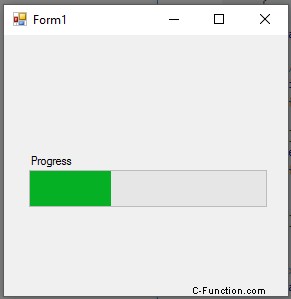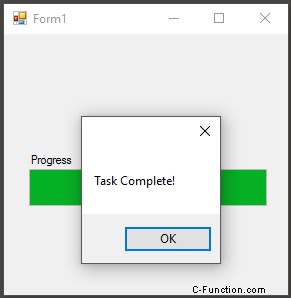# BackgroundWorker を使用してタスクを完了します。
次の例は、BackgroundWorker を使用して WinForms ProgressBar を更新する方法を示しています。 backgroundWorker は、UI スレッドをブロックせずにプログレス バーの値を更新するため、バックグラウンドで作業が行われている間、リアクティブ UI が表示されます。
namespace BgWorkerExample
{
public partial class Form1 : Form
{
//a new instance of a backgroundWorker is created.
BackgroundWorker bgWorker = new BackgroundWorker();
public Form1()
{
InitializeComponent();
prgProgressBar.Step = 1;
//this assigns event handlers for the backgroundWorker
bgWorker.DoWork += bgWorker_DoWork;
bgWorker.RunWorkerCompleted += bgWorker_WorkComplete;
//tell the backgroundWorker to raise the "DoWork" event, thus starting it.
//Check to make sure the background worker is not already running.
if(!bgWorker.IsBusy)
bgWorker.RunWorkerAsync();
}
private void bgWorker_DoWork(object sender, DoWorkEventArgs e)
{
//this is the method that the backgroundworker will perform on in the background thread.
/* One thing to note! A try catch is not necessary as any exceptions will terminate the backgroundWorker and report
the error to the "RunWorkerCompleted" event */
CountToY();
}
private void bgWorker_WorkComplete(object sender, RunWorkerCompletedEventArgs e)
{
//e.Error will contain any exceptions caught by the backgroundWorker
if (e.Error != null)
{
MessageBox.Show(e.Error.Message);
}
else
{
MessageBox.Show("Task Complete!");
prgProgressBar.Value = 0;
}
}
// example method to perform a "long" running task.
private void CountToY()
{
int x = 0;
int maxProgress = 100;
prgProgressBar.Maximum = maxProgress;
while (x < maxProgress)
{
System.Threading.Thread.Sleep(50);
Invoke(new Action(() => { prgProgressBar.PerformStep(); }));
x += 1;
}
}
}
<強い>
結果は次のとおりです...


# イベント ハンドラーを BackgroundWorker に割り当てる
BackgroundWorker のインスタンスが宣言されたら、実行するタスクのプロパティとイベント ハンドラーを指定する必要があります。
/* This is the backgroundworker's "DoWork" event handler. This
method is what will contain all the work you
wish to have your program perform without blocking the UI. */
bgWorker.DoWork += bgWorker_DoWork;
/*This is how the DoWork event method signature looks like:*/
private void bgWorker_DoWork(object sender, DoWorkEventArgs e)
{
// Work to be done here
// ...
// To get a reference to the current Backgroundworker:
BackgroundWorker worker = sender as BackgroundWorker;
// The reference to the BackgroundWorker is often used to report progress
worker.ReportProgress(...);
}
/*This is the method that will be run once the BackgroundWorker has completed its tasks */
bgWorker.RunWorkerCompleted += bgWorker_CompletedWork;
/*This is how the RunWorkerCompletedEvent event method signature looks like:*/
private void bgWorker_CompletedWork(object sender, RunWorkerCompletedEventArgs e)
{
// Things to be done after the backgroundworker has finished
}
/* When you wish to have something occur when a change in progress
occurs, (like the completion of a specific task) the "ProgressChanged"
event handler is used. Note that ProgressChanged events may be invoked
by calls to bgWorker.ReportProgress(...) only if bgWorker.WorkerReportsProgress
is set to true. */
bgWorker.ProgressChanged += bgWorker_ProgressChanged;
/*This is how the ProgressChanged event method signature looks like:*/
private void bgWorker_ProgressChanged(object sender, ProgressChangedEventArgs e)
{
// Things to be done when a progress change has been reported
/* The ProgressChangedEventArgs gives access to a percentage,
allowing for easy reporting of how far along a process is*/
int progress = e.ProgressPercentage;
}
# 新しい BackgroundWorker インスタンスの作成
BackgroundWorker は一般的に、UI スレッドをブロックすることなく、時間のかかるタスクを実行するために使用されます。
// BackgroundWorker is part of the ComponentModel namespace.
using System.ComponentModel;
namespace BGWorkerExample
{
public partial class ExampleForm : Form
{
// the following creates an instance of the BackgroundWorker named "bgWorker"
BackgroundWorker bgWorker = new BackgroundWorker();
public ExampleForm() { ...
# プロパティを BackgroundWorker に割り当てる
これにより、タスク間で BackgroundWorker をキャンセルできます
bgWorker.WorkerSupportsCancellation = true;
これにより、ワーカーはタスクの完了までの進捗状況を報告できます...
bgWorker.WorkerReportsProgress = true;
//this must also be used in conjunction with the ProgressChanged event
# 構文
# コメント
UI スレッド内で長時間実行される操作を実行すると、アプリケーションが応答しなくなり、アプリケーションが動作を停止したようにユーザーに表示される可能性があります。これらのタスクはバックグラウンド スレッドで実行することをお勧めします。完了したら、UI を更新できます。
BackgroundWorker の操作中に UI を変更するには、通常、更新するコントロールで Control.Invoke メソッドを使用して、UI スレッドへの変更を呼び出す必要があります。これを怠ると、プログラムで例外がスローされます。
BackgroundWorker は通常、Windows フォーム アプリケーションでのみ使用されます。 WPF アプリケーションでは、作業をバックグラウンド スレッドにオフロードするために Task が使用されます (おそらく async/await と組み合わせて)。 UI スレッドへの更新のマーシャリングは通常、更新されるプロパティが INotifyPropertyChanged を実装するときに自動的に行われるか、UI スレッドの Dispatcher を使用して手動で行われます。